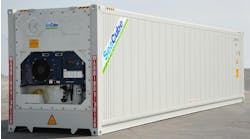Carrier Transicold’s new TRU works with EV, ICE reefer trucks and vans
Carrier Transicold is introducing North America to its all-electric Neos 200e refrigeration unit, which supports battery-operated and engine-driven commercial vans and light-duty trucks.
The engineless Neos 200e unit is part of Carrier Transicold’s growing family of eCool all-electric refrigeration systems designed to push emissions toward zero. The unit provides up to 25% greater cooling capacity, with greater efficiency than the unit it succeeds, the transport refrigeration unit (TRU) manufacturer said.
“As a greater number of battery-electric delivery vehicles are being deployed along with engine-driven counterparts, the Neos 200e unit is a solution that adapts to both types, helping florists, confectioners, grocers, and other businesses that use small, refrigerated trucks and delivery vans in achieving their sustainability targets,” said Scott Parker, truck product manager for Carrier Transicold.
On a battery-electric vehicle, the Neos 200e is powered by the vehicle’s battery supply, and on an internal-combustion vehicle, the Neos 200e is powered via the vehicle’s alternator and battery, enabling a constant cooling capacity for fresh and frozen cargoes, regardless of engine speed. The Neos 200e unit can be equipped with an electric-standby option that enables it to be plugged in and operated via a stationary power source when parked.
Features of the Neos 200e include:
- 12-volt architecture, making it fully compatible with 12-volt battery systems.
- High-efficiency performance thanks to a brazed-plate heat exchanger that provides better heat transfer, a larger evaporator coil and a 60% increase in airflow with no increase in energy consumption compared to the unit it succeeds.
- Compact design and electric operation that make for an especially quiet unit.
- Improved capacities at fresh and frozen setpoints owing to use of the new-generation refrigerant R-452A, which has about half the global warming potential of R-404A, the refrigerant traditionally used in most TRUs.
- A thin, ceiling-mounted evaporator that maximizes cargo space.
The main condenser assembly can be nose-mounted to the front of a truck box or mounted to the roof of a delivery van. With its compressor housed inside the condenser assembly, rather than on the engine as with conventional direct-drive systems, the Neos 200e unit eliminates the need to run lengthy refrigerant lines from the vehicle’s engine compartment, Carrier Transicold said. This decreases the number of fittings by 80%, which reduces the amount of refrigerant needed and the potential for refrigerant leaks.
For accessibility and ease of operation, Carrier’s Cab Command digital control system mounts in the vehicle’s passenger compartment.



